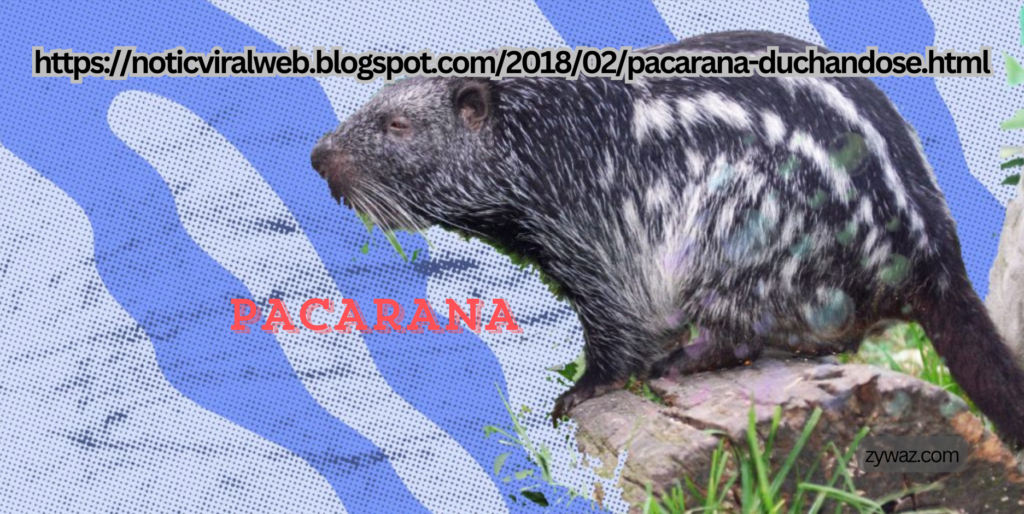The Pacarana: a Unique Rodent of Nature.
https://noticviralweb.blogspot.com/2018/02/pacarana-duchandose.html
The pacarana is one of the rare, atypical rodents populating South American tropical forests. Due to its striking size and motion as slow as molasses, one becomes easily attracted to this big, nocturnal mammal, not just in its features but also odd behaviors—one of which is showering. Description of habits, habitat, and more interestingly why it showers were discussed in this article through some world views on the pacarana.
Unveiling Showering Ritual
A Rare Behavioral Insight Undoubtedly, one of the most interesting features of this creature is its showering behavior. This particular species does the exact opposite of what most rodent species do; pacaranas were observed frequently to splash water onto their bodies, which looks much like taking a bath.This undefined behavior could be used for thermoregulation and parasite control. The sighting of a pacarana scrubbing itself impeccably is a very rare and nice scene that opens in on the entailed lives of these wonderful creatures.
Pacarana Habitat and Way of Life
Basically, pacaranas are distributed in the thick, humid forests of the Amazon Basin, where they occupy ground and low canopy layers of the forest.Their slow, steady movements and nocturnal lifestyle make them very elusive and difficult to study. Since the pacarana is a rodent, their diet consists mostly of leaves, fruits, and bark. These species of pacarana take time to pick through their foodstuffs every night. This knowledge can be paramount among the protected habitats to the food habits of the pacarana because it is under threat due to habitat loss and human encroachment.
The Pacarana in Captivity: Challenges and Opportunities
https://noticviralweb.blogspot.com/2018/02/pacarana-duchandose.html
Adaptations and Strategies for Survival
The pacarana requires special adaptations to suArvive. It would need strong limbs and very sharp claws to climb trees and burrow. Huge incisors, in turn, are needed for gnawing troublesome vegetation. A low metabolic rate would allow the pacarana to conserve energy in the poor conditions of the Amazonian rainforest, again a very important adaptation.
Problems and Potential of the Pacarana in Captivity
Although pacaranas are rarely made available to captivity, studies captive breeding and research on the animal have been of immense value. Captive pacaranas have special needs, such as a diet as natural as feasible and an environment that allows for expression of nocturnal and arboreal behaviors; it is also extremely relevant to captive research in providing knowledge regarding reproductive habits and possible release into the wild.
Pacarana Conservation Efforts and the Future
The efforts shall be aimed at protecting their natural habitat and minimizing the dangers posed to the pacarana. These will include habitat restorations, anti-poaching, education among the local communities, and so on. These efforts will sensitize locals for protection of these unique species of rodents, coupled with improving the knowledge bank on this unique rodent and its role, securing a future for this enigmatic species.
FAQs about the Pacarana
https://noticviralweb.blogspot.com/2018/02/pacarana-duchandose.html
Q: What is so peculiar about a pacarana?
A: Of course, the great size, slow movements, and showering behavior set it apart.It is one of the very few rodent species known to follow bathing rituals..
Q: Largest populations of pacaranas are found in?
A: The largest populations of pacaranas occur in the Amazon Basin, generally in the tropical forests of Brazil, Peru, and Colombia.
Q: What is in the diet of pacaranas?
A: Being herbivores, pacaranas feed on leaves, fruits, and bark.They forage at night.
Q: Why is pacarana’s showering behavior important?
A. Showering behavior of pacarana assumes thermal homeostasis and control over parasites, which is an advanced way of self-care in rodents.
Q.How can we help in the conservation of Pacarana?
A:Major steps in the conservation relate to habitat preservation, anti-poaching efforts, raising awareness with respect to pacarana ecological importance, and support of such conservation efforts.
Conclusions: The Mystery of the Pacarana Unraveled
https://noticviralweb.blogspot.com/2018/02/pacarana-duchandose.html
In this pacarana, a diverse and highly adapted life form within Amazonia is described. Large numbers of the behaviors, such as that showering ritual, tell if one cares to understand just how complex a life of a rodent may be. Further research into the pacarana to the level of conservation beyond just the preservative record would enhance how the web supporting life in one dimension worked. The more that is learned from this remarkable rodent, the more it should attract need and support to make sure its survival into posterity through conservation intervention. See more

